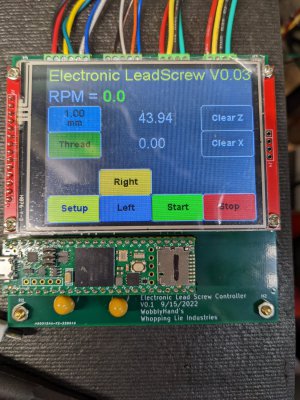I have the Clough42 code up. It's not difficult to read, but the IDE (Eclipse) is new to me. He is a programmer by trade, so he obfuscates some things from us mere mortals without even knowing it! lol.
The arduino stuff is much easier to learn. Lack of a proper IDE is somewhat painful, but honestly with the Microchip PIC24 IDE I haven't used a single breakpoint in a decade. A USB to serial cable and one I/O pin, paired with a few I/O pins and a scope is much more useful. One of my next steps will be to add that USB/Serial cable to the Teensy to get some debug information out, although the built in USB/Serial is pretty useful as is.
Have my second board and display running. Simply partially populated it, and turned it on. Easy, peasy. I'm going to use it for UI work. It's kind of a pain to be down in the shop for that sort of thing, especially if you are learning new graphics tools.
Using the Teensy libraries made my life soooo much easier. The DRO's were almost trivial, a gimme. I'm even considering upgrading my read heads so I can put in a 5um system. My current DRO heads seem to be quite old, only capable of 0.001". Found the read heads for about $54 each, and 1m of 5um tape for ~ $40-50.
The Clough42 code isn't bad, but James didn't document his source code that well. I usually put in a lot more. I know from experience that if you do something elegant, or tricky, 3 months from now, you won't have an inkling of WTF you did, especially if life happened along the way. Trust me, you can't document your code enough!
I got around ICE with good old fashioned twiddling I/O pins and a scope. Good enough to establish timing and other stuff. The Teensy outputs on the serial port at USB2 speeds, or 480Mbit/sec, which is darn good for "serial". You can get a heck of a lot of data out that port, should you need it.
The Arduino IDE V2 has been released and it has Teensy support built in. I haven't tried it yet, but it looks to be a big step forward. It's looking much more like an IDE, as compared to V1.8.19 that I am running on.
I have absolutely no regrets for taking the path that I did. This project is turning out to be far, far better than I expected. It is so much easier to develop on Teensy than on any TI platform that I have tried over the past 15 years.


